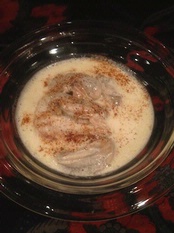WINE WITH… OYSTER STEW
There are three kinds of oyster eaters, wrote the eloquent food essayist
MFK Fisher: “Those who will eat them raw and only raw...those who with
equal severity will eat them cooked and no way other,” and those who will eat
them “hot, cold, thin, thick, dead or alive, as long as it is oyster.” Both of us fall into this third group. For us, the very sight of a shimmering
dozen or so fresh oysters reclining seductively in their pearlescent shells is
enough to make our knees go weak with desire. The delicate perfume of kelp and sea as one of the bivalves
is lifted into the air, the icy quiver of pleasure as the oyster slips through
one’s lips, then the burst of brine and calcareous essence against taste
buds—what more could a person ask for?
Well, maybe a glass of crisp Muscadet, steely Chablis, or racy Sauvignon
Blanc.
 Raw oysters, just like the wines that best suit them, are all about
electrifying flashes of vitality and crisp energy. A cooked oyster, however, becomes an entirely different
thing, particularly when it’s been simmered in cream. Whether you call it stew, pan roast,
chowder, bisque or just soup, oysters that have been gently simmered for no
more than a few minutes in cream emerge mysteriously transformed into something
plump and velvety. Salinity and
crispness morph into an elemental butteriness, while the lean, metallic ping of
raw oyster becomes mellow and yielding. Bracing wines no longer satisfy. What should you fill your glasses with instead?
Raw oysters, just like the wines that best suit them, are all about
electrifying flashes of vitality and crisp energy. A cooked oyster, however, becomes an entirely different
thing, particularly when it’s been simmered in cream. Whether you call it stew, pan roast,
chowder, bisque or just soup, oysters that have been gently simmered for no
more than a few minutes in cream emerge mysteriously transformed into something
plump and velvety. Salinity and
crispness morph into an elemental butteriness, while the lean, metallic ping of
raw oyster becomes mellow and yielding. Bracing wines no longer satisfy. What should you fill your glasses with instead?
OYSTER
STEW
Serve as a sumptuous first course for four or a main course for two.
2 tablespoons butter
1 shallot, finely minced (about 2 tablespoons)
¾ cup dry white wine
1 cup heavy cream
Salt and pepper
1 pint fresh oysters, with their liquid
2-4 slices of lightly toasted “boule” French bread*
Paprika (optional)
Melt the butter in a large non-reactive skillet. When it foams, add the shallots and cook
over medium-low heat until tender. Add the wine, raise the heat, and cook another 2 or 3 minutes;
then add the cream and simmer over medium heat for a couple more minutes. Pour the liquid from the oysters into
the pan and continue simmering for another minute or two. Check for seasoning, then add the
oysters and simmer until the edges begin to curl, which should take no more
than 2-3 minutes (overcooking will toughen the oysters). Place a slice of bread in the bottom of
each serving bowl and spoon the oyster mixture over it. Dust with paprika if desired. Serve
immediately.
*Boules are round loaves of French bread. If you can’t find one, substitute other French or Italian
bread.
This is a seductively rich and perhaps surprisingly
elegant dish, so needs a white wine with sufficient heft not to be overwhelmed
by all the butter and cream. At
the same time, though, it benefits from being paired with a wine that has a
firm acidic backbone so as not to turn fat or flabby. This is a tricky combination, and plenty of wines we tried
didn’t quite satisfy both criteria.
The five we’re recommending did, and so only enhanced the dish, making
us eager for both another spoonful and another sip.
|
Selection
|
Approx. Price
|
Comments
|
|
Byron, Santa Barbara County (California)
Chardonnay 2011
|
$15
|
Showing
plenty of vanilla and butterscotch from oak barrel aging, this wine
definitely echoed the creaminess of the stew. It displayed such impressive balance, however, that it
kept those qualities in check, and so never seemed excessive.
|
|
Mohua, Central Otago (New Zealand) Pinot
Gris 2010
(Imported by Vineyad Brands)
|
$17
|
With
ripe pear and apple fruit flavors, this dry Pinot Gris provided a very
successful match. More than any
other wine we tried, it managed to taste rich and riveting all at once.
|
|
Mulderbosch, Western Cape (South Africa)
Chenin Blanc 2011
(Imported
by Cape Classics)
|
$17
|
A taut
and steely backbone gives this opulent wine balance and harmony, making it a
fine partner for an opulent dish like oyster stew. Full of ripe autumn fruit flavor, it made the dish seem
refreshing as well as filling.
|
|
Paul
Cheneau, Penedes (Spain) Cava Demi-Sec NV
(Imported
by Pasternak Imports)
|
$12
|
The
sweetness in this sparkler may seem a bit off-putting when the wine is sipped
on its own, but the sugar gives it body and weight, and so made it a surprisingly
satisfying oyster stew partner.
|
|
Whitehall
Lane, Napa Valley (California) Sauvignon Blanc 2011
|
$18
|
Marked
by melon and fig flavors much more than citrus ones, this Sauvignon Blanc is
full-bodied enough to hold its own with a creamy dish, while at the same time
displaying plenty of crisp, bright acidity. It made for a very tasty match.
|